Overview
Uganda is a landlocked country found in East Africa, it is bordered by Kenya in the East, South Sudan in the north, the Democratic Republic of Congo in the west, Rwanda in the Southwest and Tanzania in the south. Uganda is home to a unique assemblage of elephants. This beautiful country hosts two distinct species, which include; the African Savannah Elephant and the Forest Elephant by adaption. Out of Uganda’s ten national parks, eight of them are fortunate to harbour these magnificent creatures. These are renowned locations such as Murchison Falls National Park, Queen Elizabeth National Park, Kidepo Valley National Park, Kibale National Park, Bwindi Impenetrable National Park, Semliki National Park, Mgahinga Gorilla National Park, and Mount Elgon National Park on the Kenyan side.
Click to check out our available tours.
General facts about elephants in Uganda
Social Structure: Elephants are known for their complex social structure. They live in matriarchal groups, led by the oldest and most experienced female, whereas males tend to be more solitary.
Feeding Habits: Ugandan elephants are herbivores and consume a wide range of vegetation, including grasses, leaves, bark, and fruits. They can eat between 149 to to169 kilograms of food every day depending on food availability.
Migration: Some elephant populations in Uganda engage in seasonal and altitudinal migrations in search of food and water. These movements are essential for their survival depending on the seasons, in the rainy season they tend to move at high altitudes while in the dry season, they descend for water on the river.
Communication: Elephants communicate using a variety of vocalizations, including trumpeting and rumbling sounds. They also use body language, like flapping their ears or wagging their tails, to convey emotions a general behaviour of all elephants.
Family Bonds: Elephant families are tightly knit, and they demonstrate affection and care for their young ones. Calves are typically raised and protected by the entire group.
Bathing and Cooling: Elephants enjoy the water and often take mud baths to cool down and protect their skin from insects and the sun, this is important to the elephant’s survival.
Intelligence: These creatures are highly intelligent animals known for their problem-solving abilities and impressive memory.
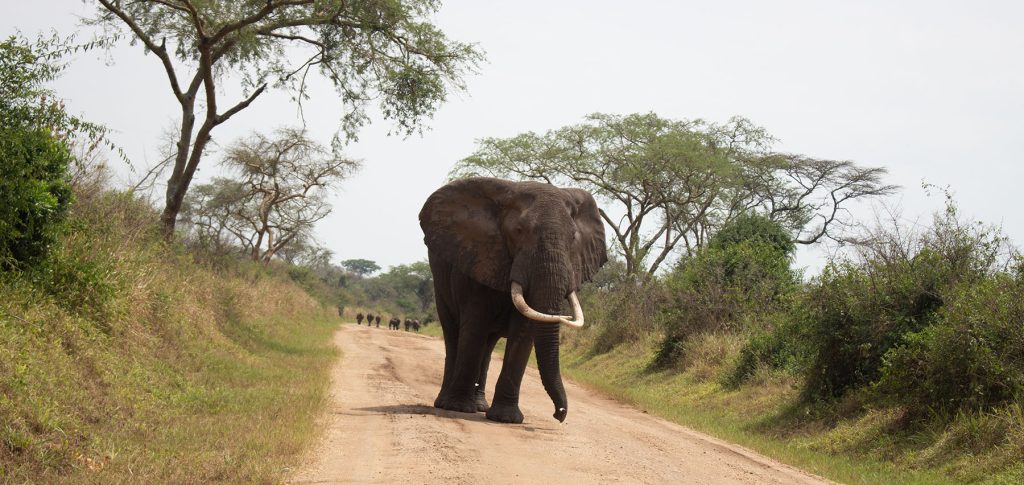
The Musth period among adult bull elephants in Uganda
Musth is a natural phenomenon that occurs among healthy adult bull elephants (both tuskers and tuskless bulls). It is characterized by the secretion of a hormone-rich substance known as temporin. This hormone is produced by the temporal gland found on either side of the elephant’s head.
Also, the secretion is accompanied by a steady trickle of urine down the back legs of the elephants, rolling tears from the eyes, and rolling the penis to the ground. It is important to note that musth involves a rise in the reproductive hormones in the elephant’s body.
Due to this change, the animal feels more restless, energetic, aggressive or unpredictable and generally irritable and oversensitive to sounds and movements. Some solitary elephants may charge easily in the Southern part of Queen Elizabeth National Park due to several factors sometimes they could have been chased from the community or run away from the war zones of Congo this should not be attached to Musth.
When does a bull start going into musth?
Young bulls generally start experiencing the musth period at around 20 years of age and this usually continues up to 55 or 60 years of age.
The importance of this phenomenon in reproduction
Temporin (the fluid secreted during musth) has a distinctive strong odour that can be smelled by both female elephants and human beings. It is however easier for female elephants to smell it and they use that scent to determine the sexual maturity and condition of the males.
How long does musth last?
This period typically lasts between 2 to 3 months and occurs in three stages. The first stage is a 3 to 4-week pre-musth condition, followed by a 4 to 5-week peak musth and then a 4 to 5-week post-musth condition.
The history of movements among elephants in Uganda
Historically, African elephants once undertook vast migrations, traversing from their ancestral lands in Northern Tanzania through the landscapes now occupied by Lake Mburo National Park and onwards into Western Uganda, Congo, South Sudan and Kenya However, the surge in human activity has disrupted these traditional migratory corridors and got these elephants stuck in the forest causing them to adapt to the forest way of life.
The elephant species in Uganda
African Savannah Elephant (Loxodonta africana):
Size: Savannah elephants are the larger of the two species, with males weighing up to 12,000 pounds and standing around 10-13 feet tall.
Tusks: Both males and females of this species can have long, curved tusks.
Behaviour: They are often found in savannah grasslands, woodlands, and open areas. They live in matriarchal family groups.
Habitat: Savannah elephants in Uganda can be found in national parks like Murchison Falls National Park and Queen Elizabeth National Park.
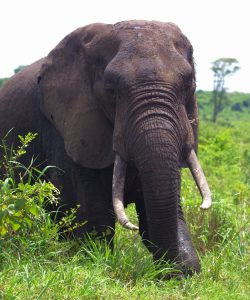
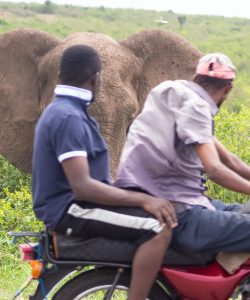
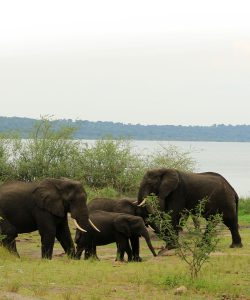
African Forest Elephant (Loxodonta cyclotis):
Size: Forest elephants are smaller than their savannah counterparts, with a smaller head, five toes at the front, four toes at the back, and more hairy, males weighing up to 8,000 pounds and standing around 7-10 feet tall.
Tusks: They tend to have straighter and shorter tusks, for easy locomotion which are often harder to see due to their habitat.
Behaviour: They are adapted to forest habitats and are more solitary compared to savannah elephants that live in the open
Habitat: In Uganda, forest elephants can be found in five national parks:
- Bwindi Impenetrable National Park
- Mgahinga Gorilla National Park
- Kibale National Park
- Semliki National Park
- Mount Elgon National Park
These elephants have adapted to the forest ecosystem and, as a result, display a wariness towards human presence, often exhibiting charging behaviour when confronted with the unfamiliar. They are distinguishable from their Savannah counterparts by their downward-facing tusks and more petite stature.
Key Points:
- The differences in size.
- Behaviour, and habitat, as illustrated above, are adaptations to their respective environments.
- It’s important to note that both species are threatened by habitat loss.
Click to check out our available tours
Behaviors among elephants in their designated National Parks
Kibale National Park witnesses the seasonal visitation of elephants from Queen Elizabeth National Park during the Chrysophyllum Albidum and Baranites williasomiana fruiting season, underscoring the interconnectedness of these ecosystems.
Conversely, three national parks in Uganda are home to the typical African Savannah Elephants with two distinct adaptations to bush and savannah environments: Queen Elizabeth National Park, Murchison Falls National Park, and Kidepo Valley National Park.
Mgahinga National Park is between 2,227 meters and 4,127 meters above sea level, while Bwindi Impenetrable National Park covers an elevation range of 1,190 to 2,607 meters. Because of the changing seasons and varying altitudes, elephants in these areas undergo altitudinal migration due to seasons.
During heavy rainfall, elephants may not need to do their usual routine of wallowing in water or mud when they are at higher cold altitudes. However, in the dry season, elephants descend to valleys and water streams to quench their thirst and use soil to protect themselves from parasites and for other reasons as they engage in wallowing.
In Queen Elizabeth National Park, elephants residing in the plains of Kasenyi in the Northern sector and the Maragambo forest in the Southern sector exhibit varying behaviours towards vehicles and humans. Elephants crossing into Congo from the Maragambo forest, are familiar with the presence of cars and engine noise. They often react with heightened sensitivity and may perceive them as threats. In contrast, elephants residing in the Northern sector, are used to regular traffic and human activity facilitated by a main road traversing the park. They are therefore generally more tolerant and less likely to charge when given space.
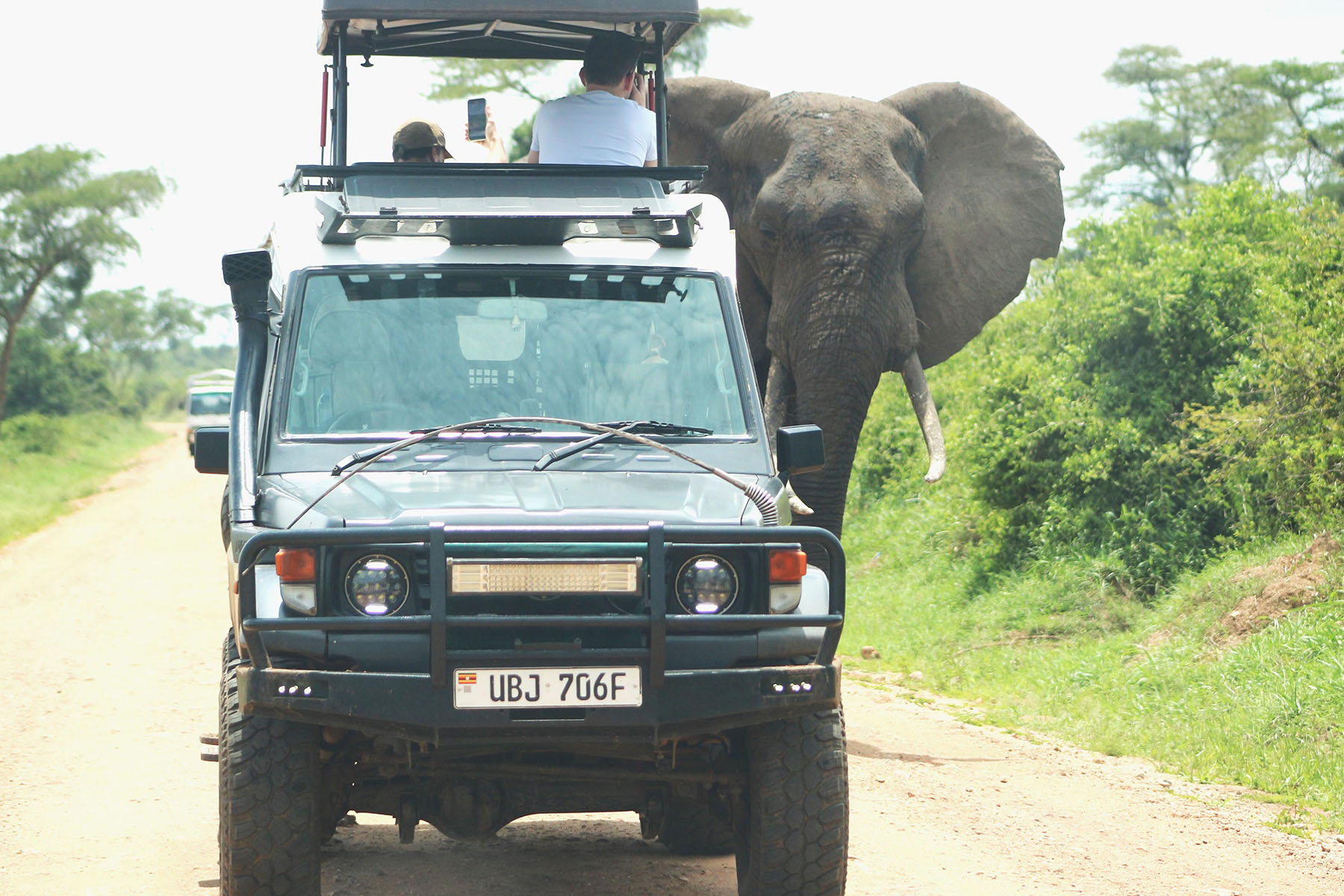
An elephant looking at a safari vehicle without any threat.
The significant impact of poaching on the behaviour of elephants in Uganda and Congo
Due to the political instabilities that plagued Uganda and Congo, a concerning trend emerged wherein poachers capitalised on the chaotic environment to exploit the region’s elephant’s tusk, These majestic creatures, known for their remarkable tusks, became prime targets for poachers seeking to profit from the illegal ivory trade. Amid this grim scenario, the elephants exhibited an incredible capacity to adapt to the dire circumstances. Over time, it became apparent that those elephants that managed to evade the ruthless clutches of poachers were evolving in response to this existential threat.
One remarkable adaptation observed among these survivors was the gradual reduction in the size of their tusks. A complex interplay of genetic and hormonal factors drove this evolutionary change. Elephants were altering their physical characteristics to protect themselves from the relentless hunting for their valuable ivory.

Single tusk Elephant in Queen Elizabeth National Park.
The response to this challenging situation was even more drastic in some instances. Perhaps owing to unique genetic variations, specific elephants stopped growing tusks altogether. This astounding transformation was a testament to the extraordinary resilience of these creatures in the face of adversity.
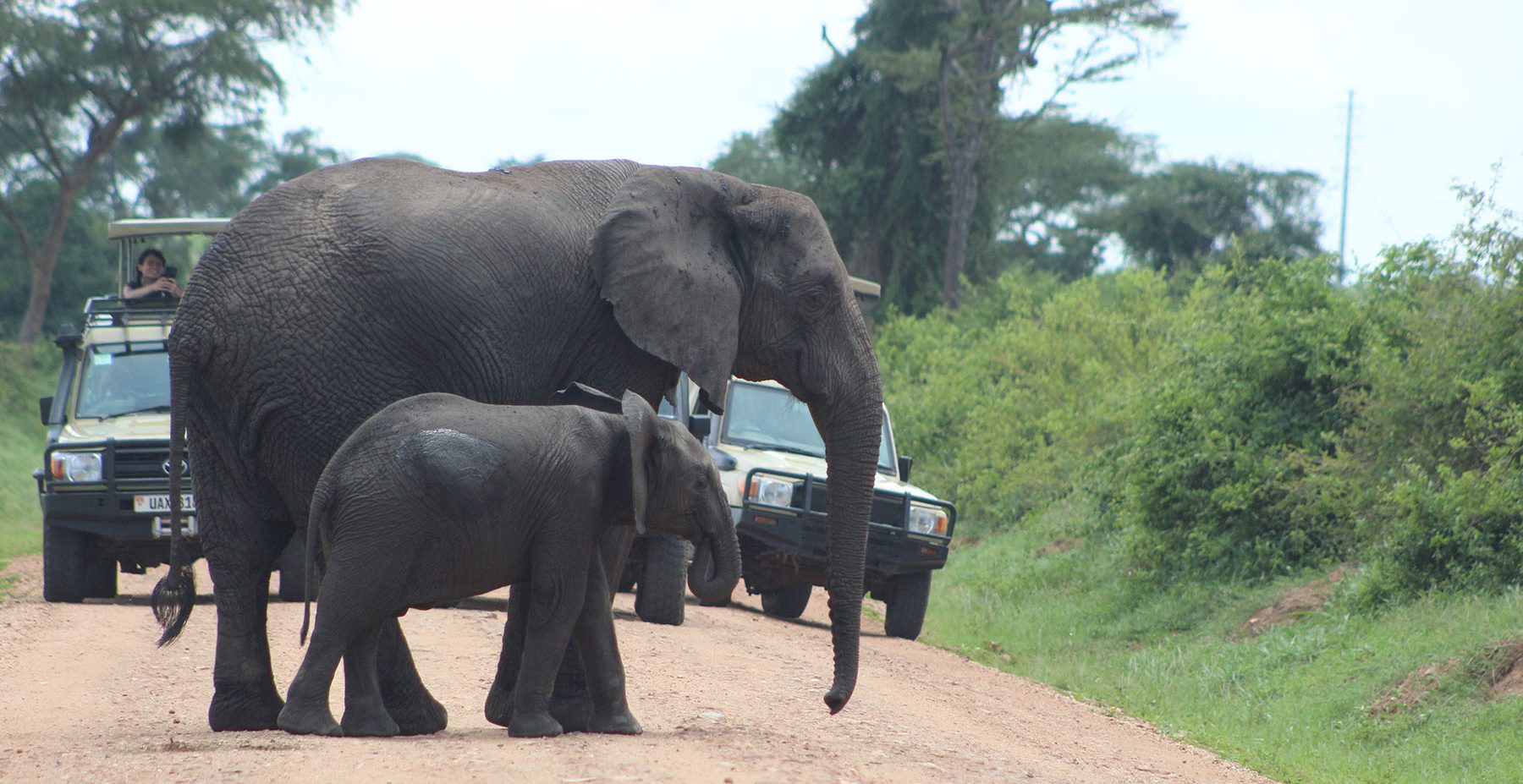
Elephant without tusks in Queen Elizabeth crossing the road.
Conservation Efforts
Due to the threats faced by elephants in Uganda such as habitat loss due to human activities, poaching for ivory, and conflicts with farmers, conservation efforts are in place to protect them and their habitats. It’s crucial to support these initiatives to ensure the long-term survival of these majestic creatures.
Murchison Falls National Park; is a mosaic of diverse ecosystems divided by the Nile’s longest River into the Northern and Southern sectors. Adapted to bush environments, elephants in the Southern sector tend to be skittish in the face of unfamiliar objects and disturbances caused by traffic. Their unique tusk orientations, with one tusk pointing up and the other down, reflect their dual adaptation to two distinct habitats. Conversely, elephants in the open savannah of the Northern sector, acclimated to human activity and traffic, exhibit a calmer disposition. However, it’s imperative to remember that they are, at their core, wild animals and human interactions must proceed with caution.
Kidepo Valley National Park, situated in North Eastern Uganda and extending into South Sudan and Kenya, sees elephants moving across borders for various reasons. The typical male elephant, Bulbu, plays a recognisable role in this landscape. In the open savannah of Kidepo, elephants are generally tranquil but may turn aggressive if they perceive a threat. Elephants arriving from Sudan and Kenya often display a cautious approach towards unusual objects like cars and artificial sound.
The special role of elephants in the ecosystem
The role of elephants in these parks is vital. Without them, there would be an overgrowth of trees and bushes, leading to significant environmental changes that could harm various animal species like Chimpanzees in Kibale National Park, and Buffalo among others this highlights elephants’ critical role as ecosystem engineers, creating pathways and food for other animals.
What do elephants feed on?
When it comes to their diet, elephants enjoy a variety of plants, including tree bark and roots. However, their dietary choices can change depending on the season and food availability, particularly during dry periods. After rainfall, trees store more nutrients, prompting elephants to push over trees or dig to access the nutritious roots. They use their feet for digging and their trunks for consuming seeds. Similarly, they dig up plants that store water underground, ensuring they remain well-fed and hydrated throughout different seasons, regardless of the national park they inhabit.
Conclusion
Elephants in Uganda’s national parks have unique ways of interacting with their surrounding environment. For instance, they use their heads to push against trees for various reasons, and use their trunks to sense, pull, scope and small.
Understanding the behaviour of Uganda’s elephants is essential. This is because of its intricate linkage to their ecological adaptations and the pressures from the growing human population. It is also crucial for conservation efforts, tourists and the co-existence of these majestic creatures in Uganda’s ever-changing landscapes.
Explore | Experience | Reminisce the elephant behaviour as we take you through this expedition. Click the link to check out our available tours.
